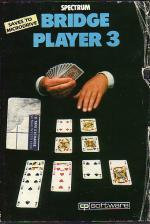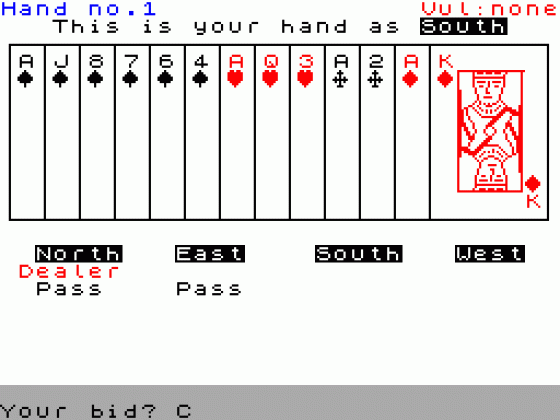Bridge Player III
The tension mounts as the quiet click of fresh cards permeates the friendly but competitive atmosphere. This is Bridge, a game involving logic, conventions, and a complete understanding between the members of both the two teams, usually highlighted by a curious argot that is ineffable to the untrained listener and understood only by other Bridge players. Bridge is a card game dearly loved by many and probably loathed by the majority, it's also best played with three other equally matched people, but in lieu of other human players, a computer version can at least bridge the gap in a lonely person's life.
CP Software have already produced several such versions and Bridge til is the latest. It comes presented in a dual tapesized box containing a single cassette and an 8-page instruction manual briefly covering the aims of the program and how it relates to the game. One thing becomes clear immediately, although a claim is made for the program's usefulness as a teaching aid, there is no way a beginner would learn about Bridge playing from either the program or the manual, and perhaps it would be unfair to expect that. As an aid in brushing up your play, it's obviously useful.
So much for the simple, onto the argot! The Acol system is the bidding convention used although it understands the Stayman and Blackwood conventions as well. Unfortunately the computer is no Omar Sharif, initiating neither of them, but it does bid in that system if asked to by the player.

You always play South, but if you win the contract with your partner (North) as the declarer, rather than sit and watch the computer take over, you can play your partner 's hand as well as your own 'dummy' hand.
Bidding may be avoided if you prefer, although this removes most of the fun of the game. At the outset, after dealing, your hand is displayed on screen, and from this you must judge your bid and start responding to your partner's counter bids, or he to yours. Bids are simply entered and displayed as a figure and letter, thus two spades is 2S and four hearts is 4H. P to pass, D to double and R to redouble. A notrump bid uses the letter N. In play the order is reversed, suit first followed by the card (A, K, 0, J for the royals, T for ten, and then numerals 9 to 2.
Hands of between 12-14 points are considered as being weak, strong being between 15- 17 points or having variable no trumps. If bidding isn't required and you just want to get down to the game then a choice must be made between either seeing all the cards or just those of the player ' s hands. After this the screen displays whichever hands have been selected and asks you to choose the contract, so for example 2H would be a contract of two hearts. If all the cards are to be displayed then a final option allows the player to choose to play all four hands or just concentrate on his own, leaving the computer to play the other two.
Dealing begins from the North hand and rotates around the cardinal positions in much the normal way. Once a contract has been declared the screen changes to reveal the hands at their appropriate positions. Displayed on screen is the number of the hand being played, contract and the declarer along with the dealer, whether or not someone is vulnerable and the last trick played and who won it. The score of the current game in tricks is also displayed at the bottom left.
The program has a number of useful features, for instance, if a card is played and there is no choice but to follow suit with only one card then the computer automatically plays it for you. During play various things may be reviewed by entering B for bidding, E for earlier tricks or you can peep at your opponents' hands by entering P. After playing a card however this information is deleted. Claiming the rest of the tricks in a hand can be done by entering Z and in blind faith the computer attributes the rest of the tricks to you it's well known that Bridge players never cheat! Recommencing play is done by pressing R. Finally, if you're the declarer and an opponent plays a trump (or 'ruff as Omar would call it), then the computer civilly alerts you to the fact by beeping.
At the end of each hand the score is shown including any penalties, slams, honours or rubber points in the familiar way and a cumulative total is displayed. After a game there is the option of replaying that same hand but with renewed bidding, taking a hard copy to printer, or going straight on to the next and. If you decide that during a game you don't wont to play any more or Omar walks in to the room and you feel distinctly embarrassed then you can abandon your current hand by pressing N or going back to the list of options by using O. A useful built in facility is to be able to load and save to microdrive. One bug seems to have crept through however, at one point, after creating four hands to play, the program crashed and revealed its protected BASIC program F Vachha the protection's author will not be pleased.
There's no doubt that if you enjoy playing Bridge, that this program has its merits, but it seems doubtful that it can do much to convince the real novice, who is likely to find the whole business quite bewildering, and at its fairly high price, possibly offputting.


 1st April 1986
1st April 1986

